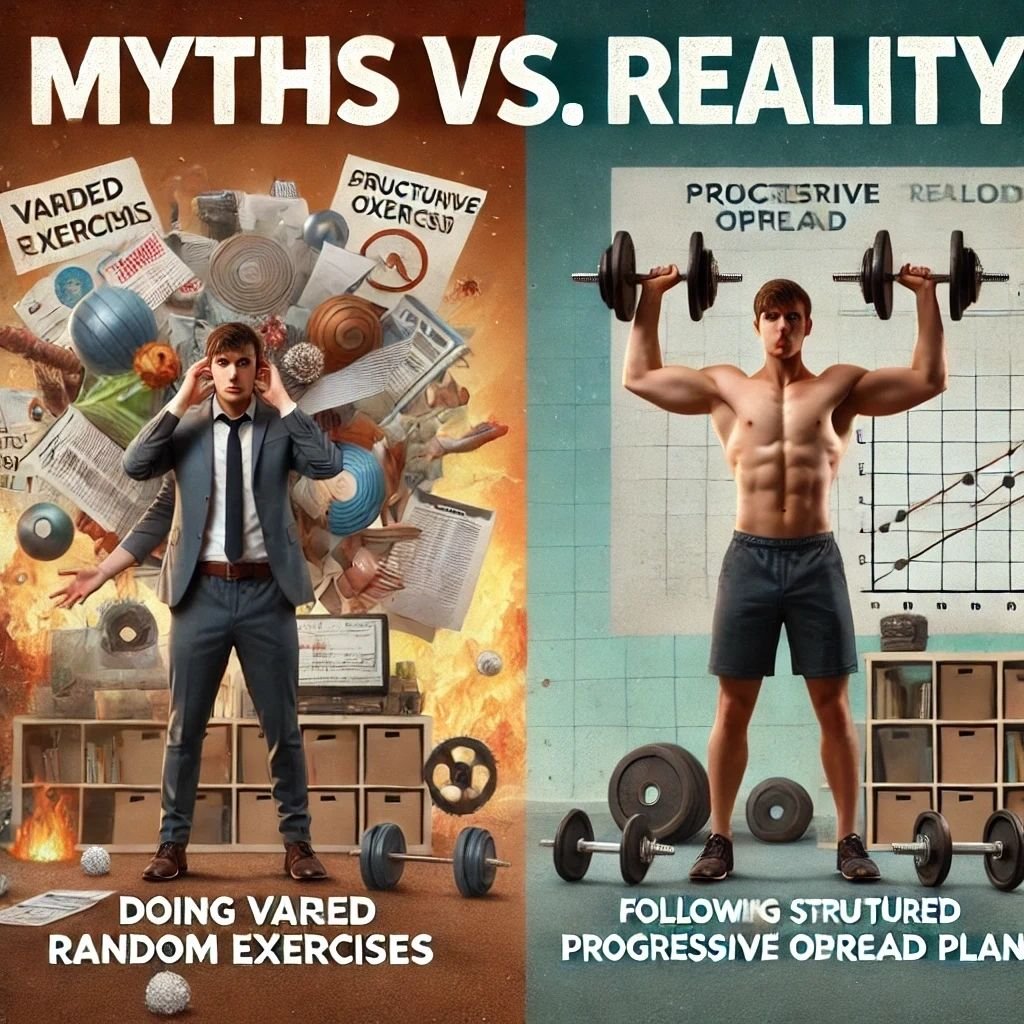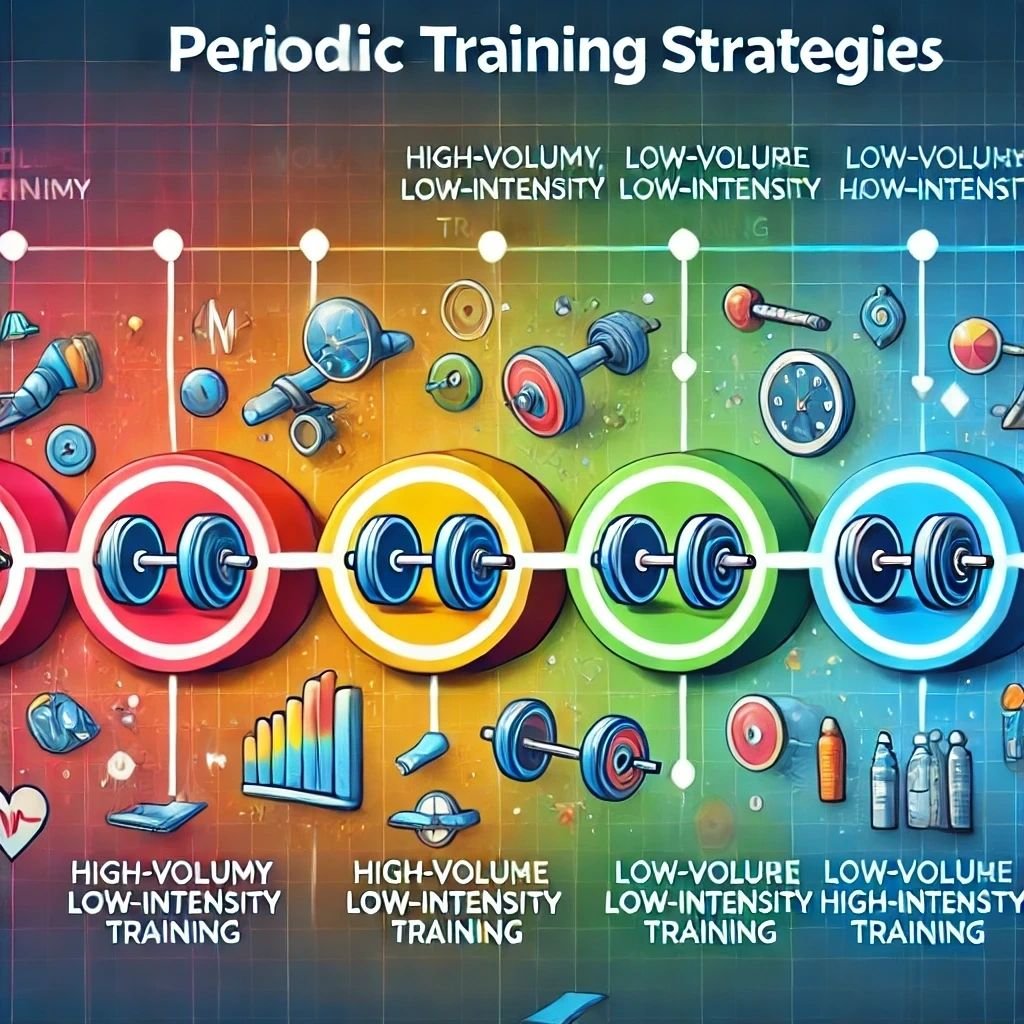Imagine you’re at the gym, and you spot a chap doing a different workout every day, swearing it’s the secret to massive gains. Welcome to the world of muscle confusion, a concept that’s been buzzing around fitness circles like a hyperactive protein shake. But is there any truth to the muscle confusion myth, or is it just another fitness fad destined for the dustbin? What’s the truth about workout variety? Let’s flex our mental muscles and sort out the facts from the fiction, shall we?
This article is an expansion of the main myths about building muscle article you’ll want to check out.
FAQs About the Muscle Confusion Myth
1. What is the muscle confusion myth?
The muscle confusion myth claims that constantly changing your workout prevents your muscles from adapting and promotes continuous growth. However, muscles don’t need to be “confused”; they respond to stress, not novelty.
2. Does workout variety help with muscle growth?
While some variety can prevent boredom and improve overall fitness, consistent progressive overload is more important for muscle growth. Studies show that structured training leads to better strength and hypertrophy results than random changes.
3. What is the role of progressive overload in training?
Progressive overload is the gradual increase of stress on your muscles through heavier weights, more reps, or increased intensity. This is the key driver of muscle growth, not constantly changing exercises.
4. Are there any benefits to workout variety?
Yes, planned variety can:
- Reduce boredom and improve adherence
- Prevent plateaus by introducing new stimuli
- Enhance motor learning and neuromuscular adaptation
5. What are the risks of following the muscle confusion myth?
Falling for the myth can lead to:
- Difficulty tracking progress
- Poor mastery of fundamental exercises
- Risk of neglecting some muscle groups
- Suboptimal muscle growth due to inconsistent stimulus
6. What’s the best way to incorporate variety into workouts?
Introduce planned variations, such as:
- Switching exercises (e.g., barbell to dumbbell) every few weeks
- Adjusting reps, sets, and rest times
- Using techniques like supersets or rest-pause training
7. What is periodisation, and how does it help?
Periodisation is a planned approach to training where intensity and volume are systematically varied over time. This allows for both consistent progression and strategic variety without random changes.
8. What’s the scientific consensus on the muscle confusion myth?
Evidence shows that progressive overload and consistency are more effective than random exercise changes. Research supports structured training methods, such as periodisation, for long-term gains in strength and muscle growth.
What is the Muscle Confusion Myth Theory?

The muscle confusion theory is like a surprise party for your muscles. The idea is that by constantly changing your workout variety, you’ll keep your muscles guessing, preventing them from adapting to any single routine. Proponents claim this unpredictability is the key to continuous growth and avoiding plateaus.
This theory suggests that muscles have a sort of memory that needs to be “confused” to stimulate growth. It’s as if your muscles have a tiny brain that you need to outsmart, cue the Mission Impossible theme! However, as we’ll explore, the reality of muscle adaptation science is a bit more complex than this simplistic view suggests. In fact, it’s about as complex as trying to assemble IKEA furniture after a few pints.
The Science of Muscle Adaptation

To understand why the muscle confusion myth persists, we need to delve into the muscle adaptation science. When you exercise, you create microscopic tears in your muscle fibres. During rest, these fibres repair themselves, growing bigger and stronger in the process. This adaptation is your body’s way of preparing for future challenges.
But here’s the truth: muscles don’t have memory in the way we think. They respond to stress, not novelty.
Your muscles don’t sit around thinking, ‘Oh no, not squats again!’ They simply respond to the load you put on them.
The key principle at work here is progressive overload. This means gradually increasing the stress placed on the body during exercise. It could be by lifting heavier weights, doing more repetitions, or increasing the frequency of workouts. The body adapts to this increased demand by becoming stronger and more efficient.
Research published in the Journal of Strength and Conditioning Research by Schoenfeld et al. (2014) found that mechanical tension is the primary driver of muscle hypertrophy. This means that the amount of force your muscles produce against resistance is more important than constantly varying exercises.
It’s like telling your muscles a progressively scarier story each night. Eventually, they’ll grow big and strong enough to handle any plot twist you throw at them.
Examining the Evidence: Workout Variety Myths vs. Reality

When it comes to scientific evidence supporting muscle confusion, it’s about as solid as a chocolate kettlebell. While some studies suggest that workout variation benefits include improved adherence and overall fitness, there’s little concrete evidence that random workout variety is superior for muscle growth compared to structured, progressive training.
A study by Baz-Valle et al. (2019) published in the “Journal of Strength and Conditioning Research” compared the effects of a fixed loading approach vs. a varied loading approach on muscle strength and hypertrophy. The results showed no significant differences between the two groups, suggesting that variation in loading schemes doesn’t provide additional benefits for muscle growth.
Another study by Damas et al. (2019) in the “European Journal of Applied Physiology” demonstrated that consistent training with progressive overload led to greater strength gains compared to frequently changing workout variety.
This research supports the idea that while some variety can be beneficial, consistency and progression are key factors in muscle development. It’s like baking a cake, you need to follow the recipe (consistency) and gradually increase the heat (progression), not randomly throw ingredients together and hope for the best.
Potential Benefits of Changing Workout Variety

Despite the myths, incorporating variety into your routine isn’t all bad. Some workout variation benefits include:
1. Reduced boredom (because watching paint dry is more exciting than doing your 1000th identical workout)
2. Improved overall fitness by challenging different aspects of physical performance
3. Potential for breaking through plateaus by introducing new stimuli
4. Enhanced motor learning and neuromuscular adaptation
Think of it as the fitness equivalent of trying new hobbies – you might discover muscles you didn’t know you had.
A study by Fonseca et al. (2014) in the “Journal of Strength and Conditioning Research” found that varying exercise selection can lead to greater overall strength gains compared to using the same exercises consistently. However, this doesn’t mean you should change your entire routine daily – it’s more like adding a plot twist to your favourite TV show every few episodes, not changing the entire cast and storyline every week.
Drawbacks and Criticisms of The Muscle Confusion Myth
However, falling for the muscle confusion myth can lead to some pitfalls:
1. Difficulty in tracking progress and implementing progressive overload
2. Risk of overtraining some muscle groups while neglecting others
3. Hindered skill development and mastery of fundamental exercises
4. Potential for suboptimal muscle growth due to lack of consistent stimulus
A review by Kraemer and Ratamess (2004) in the “Medicine & Science in Sports & Exercise” journal emphasised the importance of specificity in resistance training. Constantly changing exercises can prevent the development of proper form and technique, which are essential for safe and effective training. It’s like trying to master the art of tea-making by switching to a different beverage every day – you might end up a jack of all trades, but a master of none.
My Opinion and experience of Changing Workout Variety
The fitness community’s stance on muscle confusion is about as unified as a group of cats herding sheep. However, most experts agree that while some variety is beneficial, structure and progression are key.
Common sense has to prevail. Your muscles aren’t sentient (HENCE THE MUSCLE CONFUSION MYTH) and providing you’re challenging them every workout and improving with progressive overload in mind, you’ll make progress. This assumes your nutrition and rest is also on point.
The idea isn’t to confuse your muscles, but to challenge them consistently and ensure the mind to muscle connection remains strong. Periodic training strategies that incorporate planned variations are far more effective than random changes.
The body thrives on a balance between consistency and novelty. While introducing new stimuli can be beneficial, it should be done in a structured manner that allows for progressive overload and skill development.
Within the further useful reading section below, you’ll encounter my article link on Hybrid training. Within this blog post I elaborate on my time participating in Cross-fit (muscle confusion at its finest).
personally I prefer to milk an exercise to the point when I can’t progress anymore and switch to another variation – e.g Barbell incline chest press to dumbbell incline press. or Weighted pull-ups to chin ups. This is about as adventurous as my muscle confusion journey takes me.
Alternatives to Random Workout Variety Changes

Periodisation
Periodisation involves planned changes to your training programme over weeks or months. It’s like a well-structured novel, with different chapters focusing on various aspects of your fitness.
Example: A 12-week programme might start with 4 weeks of high-volume, low-intensity training, followed by 4 weeks of moderate volume and intensity, and finish with 4 weeks of low-volume, high-intensity training.
Progressive overload:
This technique involves consistently challenging your muscles by incrementally increasing the demands placed on them. It’s akin to gradually turning up the difficulty on your favourite video game.
Example: If you’re currently bench pressing 60 kg for 3 sets of 8 reps, you might aim to increase this to 62.5 kg, or try for 3 sets of 9 reps in your next session.
Undulating periodisation
This approach involves changing the training variables more frequently, often within the same week. It’s like having a varied weekly meal plan, with different nutritional focuses each day.
Example: Monday might be a heavy, low-rep day for squats (e.g., 5 sets of 3 reps at 85% of your one-rep max), whilst Thursday could be a lighter, high-rep day (e.g., 3 sets of 12 reps at 65% of your one-rep max).
Block periodisation
This method involves dedicating blocks of time (usually several weeks) to developing specific fitness qualities. It’s similar to focusing on one subject intensively before moving to the next in your studies.
Example: You might spend 6 weeks focusing primarily on building strength (low reps, heavy weights), then switch to a 6-week block emphasising muscular endurance (higher reps, moderate weights).
These periodic training strategies provide the benefits of variety whilst maintaining the structure necessary for consistent progress. It’s like having a varied diet whilst still ensuring you get all your necessary nutrients.
Research by Harries et al. (2015) in the “Sports Medicine” journal found that periodised resistance training programmes resulted in superior strength gains compared to non-periodised programmes. This suggests that planned variation, rather than random changes, is the key to long-term progress.
By incorporating these techniques, you can reap the workout variation benefits without falling prey to the muscle confusion myth. Remember, the goal is to challenge your muscles consistently and progressively, not to bamboozle them with constant, unpredictable changes. After all, your muscles may not have tiny brains, but they do appreciate a well-structured training plan!
How to Incorporate Workout Variety Effectively
If you want to reap the workout variation benefits without falling for the muscle confusion myth and bro science, try:
1. Planned variation in exercise selection (e.g., switching from barbell to dumbbell exercises every few weeks)
2. Manipulating training variables like sets, reps, and rest periods
3. Incorporating different training styles (e.g., supersets, drop sets, rest-pause training) within a structured programme. You’ll find a busy dads article and a dedicated article link on rest pause training below. These go into depth on drop sets and supersets.
4. Utilising different equipment (e.g., free weights, machines, resistance bands) for similar movement patterns
Remember, the goal is to challenge your muscles progressively, not to turn your workout routine into a chaotic Tamagotchi feeding schedule (remember them?). Just as those digital pets thrived on consistent care rather than random button mashing, your muscles respond best to structured, planned progression rather than haphazard exercise changes.
A study by Simão et al. (2012) in the “Journal of Strength and Conditioning Research” found that varying the order of exercises within a workout can lead to greater strength gains in certain muscle groups. This suggests that small, planned changes can be beneficial without resorting to complete routine overhauls.
Key Takeaways
1. The Muscle confusion myth lacks strong scientific evidence for superior muscle growth
2. Workout variety benefits include improved adherence and overall fitness
3. Muscle adaptation science shows that progressive overload is key for growth
4. Periodic training strategies can provide variety without sacrificing structure and progress
5. Consistency and planned variation are more effective than random workout changes
6. Evidence-based approaches like periodisation and progressive overload yield better long-term results
Conclusion – Don’t Fall For the Muscle Confusion Myth
As we wrap up our journey through the land of the muscle confusion myth, it’s clear that while variety can spice up your fitness life, it shouldn’t be the main course in your muscle-building meal plan. The workout variety benefits are real, but they should be incorporated strategically, not randomly.
Understanding muscle adaptation science helps us see that muscles respond to consistent challenge, not constant surprise. By employing periodic training strategies, you can keep your workouts interesting and effective without sacrificing the principles that drive real progress.
So, while you don’t need to marry your workout routine, you also don’t need to treat your gym sessions like a blind date with a new exercise every day. Find a balance that works for you, keep challenging yourself, and remember – the only real confusion in your fitness journey should be trying to decipher the ingredients list on that new pre-workout supplement.
Now go forth and train smart, your muscles may not have tiny brains, but you certainly do! And who knows, with the right balance of consistency and variety, you might just become the next gym legend. Just don’t let it go to your head, or you might not fit through the door!
As always, thanks for reading. You can subscribe to my website right below this post. You’ll be on my newsletter list and receive a notification the moment I release anything exciting (it’s imminent) and be alerted of new blog post publications.
Chat soon,
Matt.


3 thoughts on “Debunking the Muscle Confusion Myth: The Truth About Workout Variety”
Comments are closed.